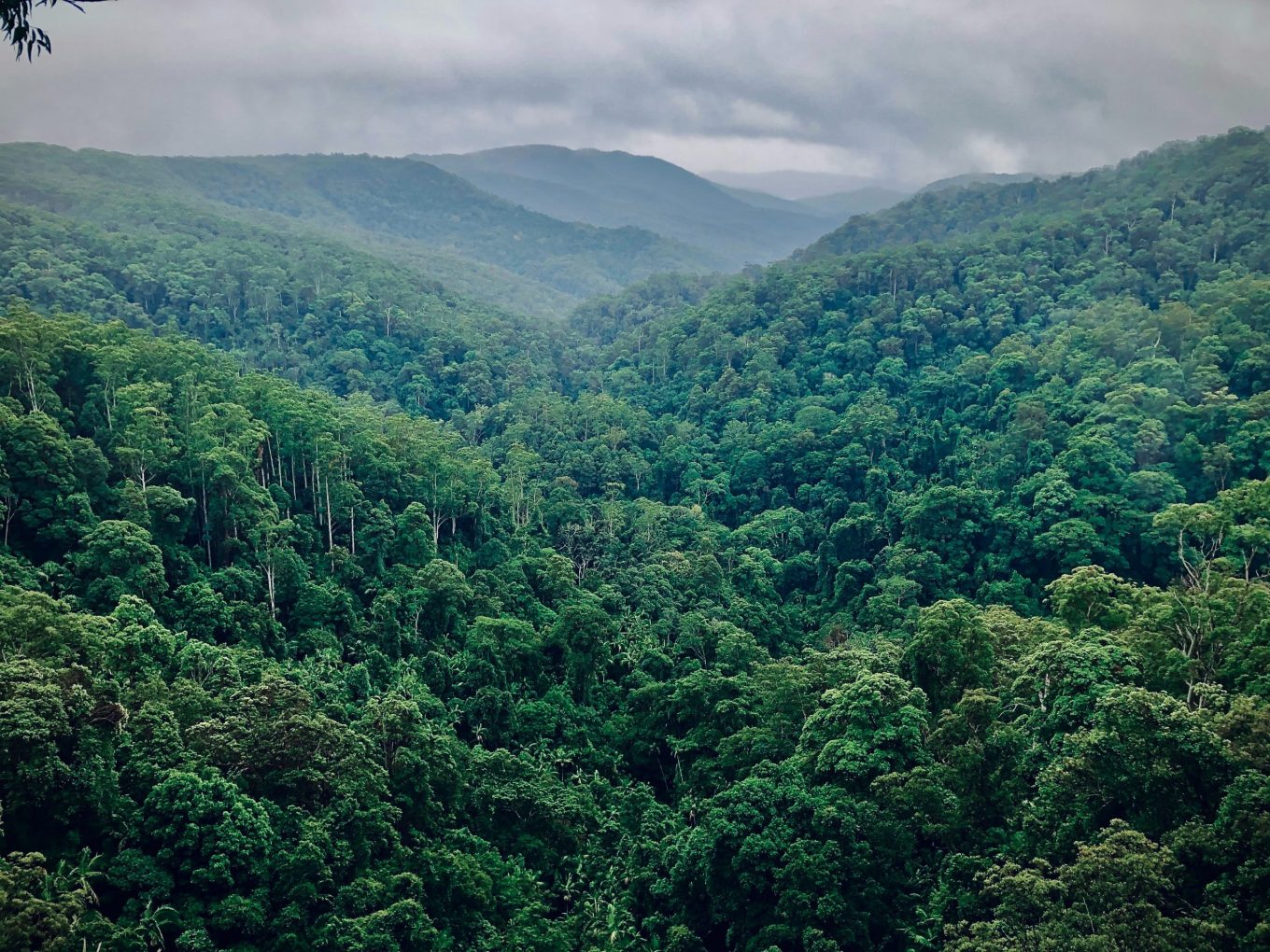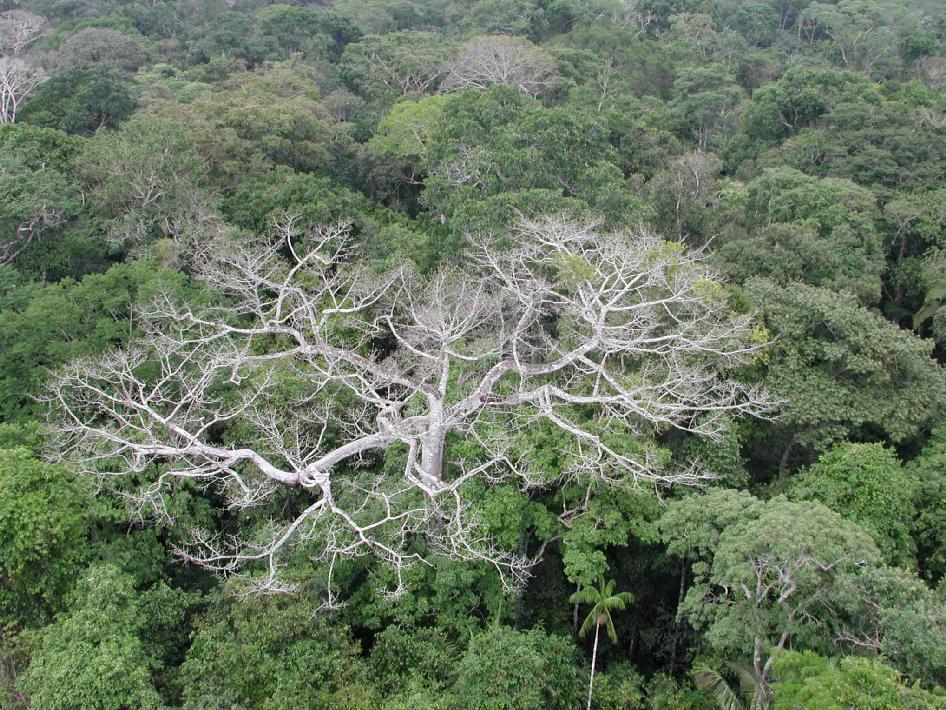
by DGR News Service | Feb 16, 2024 | Colonialism & Conquest, NEWS, Protests & Symbolic Acts
Editor’s Note: Last November, an Ecuadorean appeals court ruled to return the land back to the ownership of Siekopai People. Since the early 20th century, the Siekopai have suffered due to rubber plantation, drawing of an international border through their land, oil exploration, deforestation for pastures and monocultures, Christian missionaries, among many others. A return of their land is a landmark judgment, and came after years of organizing. The following is a brief story that came out soon after the return of their land.
For a more historical background on the issue, check this story.
Land Returned to Siekopai People
By Brett Wilkins/Common Dreams
Amazon defenders [last November] cheered what one group called “an invaluable precedent for all Indigenous peoples fighting to recover their lands” after an Ecuadorean appeals court ruled in favor of the Siekopai Nation’s ownership claim over its ancestral homeland.
The November 24 decision by a three-judge panel of the Sucumbios Provincial Court of Justice gives Ecuador’s Ministry of the Environment 45 days to hand over title to more than 104,000 acres of land along the country’s border with Peru.
“Today is a great day for our nation,” Siokepai Nation President Elias Piyahuaje said following the ruling. “Until the end of time, this land will be ours.”
The Siekopai—who call their homeland Pë’këya—were forcibly displaced from the region, one of the most biodiverse on the planet, in 1941 during the first of three border wars between Peru and Ecuador. They were then prevented from returning home as the Ecuadorean government unilaterally claimed ownership of Pë’këya.
The ruling marks the first time that an Ecuadorean court has ordered the return of land stolen from Indigenous people.
Amazon Frontlines—a San Francisco-based advocacy group that helped the Siekopai with their case—explained:
With a population of barely 800 in Ecuador and 1,200 in Peru, the Siekopai are on the brink of cultural and physical extinction. On both sides of the border, the Siekopai are currently waging legal battles to recover more than a half-million acres of land that were stolen from their ancestors. The Siekopai’s court victory recognizing Pë’këyamarks a major stepping stone in this binational struggle for the reunification of their ancestral territory. After centuries of violence, racism, and conquest by colonizing missions, rubber corporations, and governments, the court’s recognition of the Siekopai as the owners of Pë’këya is an indispensable step towards restoring justice and guaranteeing their collective survival and the continuity of their culture.
“For over 80 years, we have been fighting to get our land back,” Piyahuaje said. “Despite all the evidence regarding our land title claim—even historians testified that our ancestors dwelled in the area since the time of conquest—the Ecuadorian government failed to uphold our land rights time and time again.”
“We are fighting for the preservation of our culture on this planet. Without this territory, we cannot exist as Siekopai people,” he added.
Amazon Frontlines attorney Maria Espinosa said that “this victory has been decades in the making, it has been a very long struggle against the government.”
“Now, finally, the Siekopai’s dream of recovering their ancestral territory has been achieved,” Espinosa added. “This groundbreaking precedent paves the way for other Indigenous communities who dream of recovering their territories within protected areas.”

by DGR News Service | Sep 4, 2021 | Culture of Resistance, Mining & Drilling, Movement Building & Support, Repression at Home, Toxification
- The town of La Merced de Buenos Aires, in Ecuador, gained notoriety when it was invaded by illegal miners in 2017; for almost two years, the area was plagued by violence, prostitution and drug addiction.
- Authorities evicted the miners in 2019, but now the land may become home to legal mining operations, which many residents emphatically oppose.
- More than 300 people spent over a month blocking the path of the machinery, trucks and employees of Hanrine Ecuadorian Exploration and Mining S.A.
- The Ombudsman’s Office warns that confrontations will arise and has called on local, regional and national authorities to take immediate action.
This article originally appeared in Mongabay.
Featured image: This mountain in the parish of Buenos Aires was the epicenter of illegal mining between 2017 and 2019. Image by Iván Castaneira/Agencia Tegantai.
By Antonio José Paz Cardona | Translated by Sarah Engel
In 2017, the name “La Merced de Buenos Aires,” or simply “Buenos Aires,” became famous throughout Ecuador. This small parish located high in the Andean province of Imbabura was invaded by illegal miners who quickly took control of the mountains.
Giant mining camps made up of plastic tents garnered media attention, and the illegal nature of the mining brought violence, fear, and hopelessness to the area. The population that traditionally lived there cried out for help so that their territory would return to the tranquility that had characterized it in the past.
Several residents interviewed by Mongabay Latam say the gold rush attracted people from Peru, Venezuela, Colombia and southern Ecuador who intimidated the community. Former fighters from the now-dissolved FARC guerrilla group in Colombia even began to collect “vaccinations” — protection payments in exchange for not infringing upon them — and started to suppress the community in an attempt to dominate the illegal mining business.
In July 2019, 1,102 police officers, 1,200 soldiers and 20 prosecutors arrived in the area as part of an operation called “Radiant Dawn” (“Amanecer Radiante”). In the first few days of the raid, they managed to remove about 3,000 people from the mining camps. The operation also dismantled 30 gold-processing plants and a complex system of pulleys for transporting the gold. According to María Paula Romo, the minister of government at the time, the illegal gold trade in Buenos Aires was valued at about $500,000 per week.
For almost a year, an apparent sense of peace fell over the community. But in 2020, residents realized their land was being considered as a potential mining site again — this time in search of copper — by a company owned by an Australian firm. Since November 2017, the company has obtained eight mining titles in the area, one of which overlaps with the illegal mining area. The situation became increasingly tense in April, when more than 300 residents of Buenos Aires staged a protest on the outskirts of the parish in an attempt to stop the company’s trucks and machinery from starting mining activity in the territory.
Mining company sues dozens of people
The residents of Buenos Aires have declared their resistance. They say that since 2017, they have been invaded by illegal mining in this area, which has traditionally been dedicated to agriculture and cattle ranching. Now that legal miners want to exploit the land, many residents say they do not want any further involvement with mining.
The problem, according to a resident who asked not to be named for fear of retaliation, is that the resistance movement has generated a stigma. “They told us that we are illegal miners and that we do not want legality because we want to return to what is illegal. But this is false,” the resident said.
Natalia Bonilla, from the organization Acción Ecológica, says that when her organization began to work with the residents, they realized that the portrayal of the community members as illegal miners was not truthful. “It is a community of farmers, ranchers and agricultural people that was invaded by illegal miners. They marked them as illegal miners and made them invisible,” Bonilla said.
Favio Ocampo is the head of operations of Hanrine Ecuadorian Exploration and Mining S.A., the company that holds the mining titles and is a subsidiary of Australian company Hancock Prospecting. Ocampo said in an interview with Primicias, an Ecuadoran media outlet, that “there is a group of residents of La Merced de Buenos Aires that is polluting with illegal mining and that is now disguising itself as an anti-mining group. This group has taken the entrance to La Merced de Buenos Aires, claiming that the town is against legal and illegal mining, but they are the same [ones who] have legal proceedings against them for illegal mining.”
This is where the issue becomes more complicated. Using the argument that the opposing residents who are blocking the company’s entry into the land are illegal miners, Hanrine has launched civil and criminal actions against several people from the community, including some local authorities. “We are going through five criminalization proceedings. They are doing this to undermine the resistance of this peaceful protest that we’ve had since April 19,” said another resident of the area who asked not to be named. “The latest thing they have accused us of is unlawful association. They have even accused the president of the decentralized autonomous government [GAD] of the rural parish of Buenos Aires.”
Yuly Tenorio is a lawyer specializing in the environment who says that while some people denounced by the company may be linked to illegal mining, the vast majority are defenders of the territory who are being persecuted. This is why she has decided to defend them. According to Tenorio, Hanrine has denounced about 70 people from the area, including several Awá Indigenous people from the Palmira community who live in the forests of Buenos Aires and oppose mining.
“Not everyone has received notice because they live in very remote areas, and the Awá do not have a stable territory. Many of them do not even have a form of identification,” Tenorio said.
The five legal processes are in the pretrial investigation phase. Three of the proceedings are for alleged damage to property, one is for intimidation, and the last is for alleged unlawful association.
“The company is denouncing them via criminal and civil action to recover the alleged money that it has lost due to citizen resistance,” Tenorio said. “The objective is for the community to exhaust themselves by hiring lawyers for their defense instead of dedicating themselves to protecting their territory, requesting information, or precautionary measures.”
Ocampo said Hanrine has attempted to enter one of its mining concessions, called “Imba 1,” for several months, “but our attempts have been blocked by these people who have taken the entrance of the parish of La Merced de Buenos Aires, within full view of the police.”
“All the people in our favor and who work with us, or who provide any type of service to us, have been injured, intimidated, and threatened,” he added.
The tension between the community and the company has escalated to new levels. On April 21 this year, the Ombudsman’s Office said in a public announcement that the government will be responsible for the criminal proceedings of the Buenos Aires community leaders and those who are defending human rights and the rights of nature.
When contacted by Mongabay Latam, ombudsman Edwin Piedra confirmed that criminal proceedings have been initiated that are in the domain of the Prosecutor’s Office and are under investigation. But he added that “the Ombudsman’s Office hopes that the requests will be considered and that the prosecutor’s office will archive the proceedings, since those who exercise the right to resist cannot be penalized for common crimes like unlawful association and other types of criminal offenses, which can serve to threaten and harass people and therefore hinder their defense work.”
Lack of environmental and prior consultations
While the conflict between the residents and the mining company continues, illegal mining in the area has left damage that has not yet been fully evaluated. The only concrete data so far comes from a report by Ecuador’s Ministry of Environment and Water (MAAE) at the time of the Radiant Dawn operation. The report says 54.38 hectares (about 134 acres) of deforestation was found, along with changes to water flows, inadequate management of solid waste, and changes in water and soil quality.
More than two years since the removal of the thousands of illegal miners, it’s still not clear who will be held responsible for this damage and for rehabilitating the environment. The Ecuadoran government has not conducted an in-depth analysis, and the mining company hasn’t accepted responsibility for these costs within its concession.
Ocampo said Hanrine takes no responsibility for the damage already done.
“The government needs to take action,” he said. “We have not received any report by experts from the government about the calculation of the environmental damage. It is not the responsibility of Hanrine. Once the expert report is done, the government should identify those who are responsible.” They know who they are, he added, and they should prosecute them, because the people who profit from the illegal mining remain free.
The company says it has the right to enter its mining concessions to continue its advanced prospecting for copper. However, the difficult socioenvironmental conflict that exists in Buenos Aires complicates the situation.
The community says the company has never publicized the mining project and that neither they nor the Awá Indigenous people participated in an environmental consultation or a free and informed prior consultation. Piedra says government institutions should have sufficiently informed the community about the consultation processes that would have been conducted, and that they permitted the acquisition of environmental permissions for the concessions. “It is the responsibility of the government to comply with this obligation before granting concessions and permissions,” Piedra said.
Mongabay Latam contacted the MAAE to learn whether there was an environmental consultation but did not receive a response by the time of this article’s publication in Spanish.
No access to information
Access to information has also been an obstacle for the Buenos Aires community. According to several residents interviewed by Mongabay Latam, the company has told them it does not need to show documentation to them, so they have had to make formal requests to government entities. These entities have delayed their responses or not given complete answers, arguing that the information being sought is sensitive in nature.
“We still do not know the environmental management plans or whether environmental impact studies exist that are not a copy of other studies,” Tenorio said. Mongabay Latam also asked the MAAE whether it had granted environmental permits to Hanrine but did not receive a response.
The Ombudsman’s Office said it was “urging the Ministry of Environment and Water, the Ministry of Energy and Non-Renewable Natural Resources, and the Agency of Regulation and Control of Energy and Non-Renewable Natural Resources not to grant environmental permits or mining concessions until they proceed with the integral repair of the rights of nature, due to the existence of environmental liabilities, and they must begin the necessary measures for the restoration of nature.”
Buenos Aires community leaders say they hope for a popular consultation to prohibit mining in their territory. On May 10, some residents who want to ban both illegal and legal mining requested precautionary measures before the constitutional judge for the province of Imbabura, Manuel Mesías Sarmiento, to guarantee the removal of the camps that Hanrine has set up in public areas, and the prohibition of the entrance of heavy machinery and any other vehicles owned by the company.
One of the people who signed this action was assembly member Mario Ruiz Jácome. “The idea is to preserve the physical and psychological well-being — and the life — of the community of Buenos Aires and of the employees of the Hanrine company,” he said. “We are at an imminent risk of having confrontations that put their lives and their physical well-being in danger.”
He added that, at the entrance to the parish, there are still about 120 trucks and about 250 company workers. They stay in overcrowded conditions without restrooms, which endangers the health of everyone in the area.
Those defending this territory high in the mountains in Imbabura are awaiting a response to the precautionary measures as they continue to block the entrance of the mining company into their territory, especially given the uncertainty of the potential outcomes of the legal proceedings against them. “We want the new government to create an amnesty process for the defenders because resisting is a constitutional right, not a crime,” said Tenorio, the lawyer.
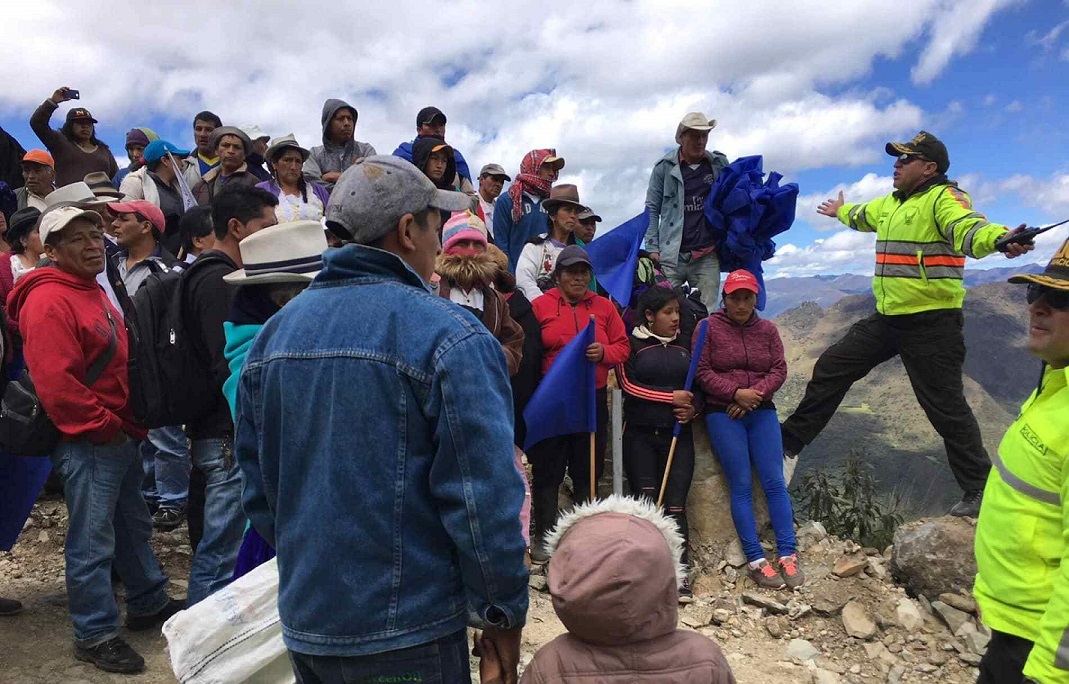
by Deep Green Resistance News Service | Jul 26, 2018 | Lobbying
Featured image: Molleturo communities visit the site of the Rio Blanco mine to make sure the activities are suspended as required by a court order.
by Manuela Picq / Intercontinental Cry
Last June, an Ecuadorean court ordered the suspension of all mining activities by a Chinese corporation in the highlands of Rio Blanco, in the Molleturo area of the Cajas Nature Reserve. It was a local court in Cuenca that gave the historic sentence: a court shut down an active mine for the first time in the history of Ecuador. Judge Paúl Serrano determined that the Chinese private corporation Junefield/Ecuagoldmining South America had failed to consult with the communities as required by Ecuador’s Constitution and by the UN Declaration on the Rights of Indigenous Peoples (UNDRIP).
Judge Serrano deemed the mining activity illegal and ordered the corporation to immediately suspend all its activities. Within two weeks, local communities accompanied police forces and local government officials in monitoring that the court order was respected.

Police and Molleturo communities discuss procedures to monitor the suspension of mining activities. Photo: Manuela Picq
The company appealed, and pressure was on the rise for the following hearing. The Chinese corporation privately offered $18 million to community leaders. Ecuador’s President, the Minister of Mines and the Minister of the Environment visited the province to pressure the local courts and indigenous communities to accept the mining activity. They defended “sustainable” mining as a form of development.
Affected communities consolidated their resistance, monitoring the access to the mine to impede mine workers to enter their territories, building support from neighboring communities, and informing the international community of the legal stakes.

Photo: Manuela Picq
On July 23, 2018, the court met again to either ratify or revert the decision to suspend mining activities in Rio Blanco. The court listened to all sides along with some expert testimonies; but there were discrepancies among the judges who postponed their verdict for another week.
Molleturo’s lasting vigilance for their waters
The Rio Blanco mine is located in the Molleturo-Mollepongo region, above ten thousand feet in the Andes. The mining license encompasses approximately six thousand hectares of paramos, lakes, and primary forests that nourish eight important rivers. This area replenishes the water system of the Cajas National Park, one of the largest and most complex water systems of Ecuador, which covers over a million hectares and holds immense water reserves.
The area is recognized as a natural biosphere reserve by UNESCO. These mountains have long been the home of Kañari-Kichwa indigenous communities. There are 12 archeological sites in the Molleturo area alone: the most famous one is the Paredones archeological site, located right by the mine.

Photo: Manuela Picq
The area is also a vital supply of water. These paramos provide water to 72 communities in Molleturo, freshwater to towns in the southern coast of Ecuador and to the city of Cuenca, the country’s third largest city which praises the quality of its drinking water.
The Rio Blanco mine is expected to be active for seven years, removing about 800 tons of rock per day and using cyanide to extract gold and silver. This entails an estimate of one thousand liters of water per hour that would be contaminated with deadly toxic waste, including arsenic, before being thrown back into rivers and soil.
Local indigenous communities were never consulted prior to the development of the project that would benefit from a recent Ecuadorean law incentivizing foreign investment. Nor did they give their consent to the licensing of their territories to the Junefield corporation. They reject the mine because it would contaminate their waters.

Photo: Manuela Picq
Women are at the forefront of the resistance that began almost two decades ago, when the mining license was first issued. Molleturo communities have been arguing in defense of water more or less actively over the last decade and a half but stepped it up when the mine started its activity in May 2018. Protests exploded, and a group burned out the miner’s living quarters.
Nobody was hurt in the explosion, but the police intervened, heavily armed, to militarize the area. The next day, protesters called in the president of Ecuador’s Confederation of Kichwa People Peoples for help, Yaku Perez Guartambel, but workers from the mine kidnapped him for eight hours, threatening to kill him. Tensions boiled to new heights.
Prior consultation as a fundamental indigenous human right
The Judge ordered the suspension on the mine–invoking constitutional and international indigenous rights to prior consultation.

Rosa, a delegate from the Andean Network of Indigenous Organizations (CAOI), discusses the territorial dimension of self-determination to community members gathered in the páramos of the Cajas mountain range. Photo: Manuela Picq
Since 1989, Art. 6 of the International Labor Organization Convention 169 safeguards indigenous rights to prior consultation on projects taking place on indigenous territories. Art. 18 of UNDRIP establishes indigenous rights to participate in decision making relating to their territories, and Art. 19 establishes that states must consult “in good faith” to obtain indigenous “prior, free, and informed consent: about legislative of administrative measures impacting their communities. In 2016, Art. 25 of the American Declaration on the Rights of Indigenous Peoples reiterated these principles in the context of the Organization of American States.
Prior consultation is not a simple law; it constitutes a fundamental human right of indigenous peoples because their existence is intimately tied to their territories. Their culture, lifeways, and community structures are woven into territorial autonomy.
An Amicus Curiae from a Chinese environmental lawyer
About half a dozen amicus curiaes were presented to Cuenca’s court supporting the communities right to prior consultation, from a range of organizations including the Environmental Defense Law Center, Ecuador’s Ecumenic Commission of Human Rights (CEDHU) and the Ecuadorian group Critical Geographies. Amicus were presented by scholars from Ecuadorean and American universities, including Universidad Internacional del Ecuador, Universidad de Cuenca, Universidad San Francisco de Quito, American University, and Coastal Carolina University.
Environmental lawyer Jingjing Zhang, from Beijing, submitted an amicus in which she provided an overview of relevant Chinese laws and regulations. She testified to the court on July 23, 2018, explaining that China ratified the UN Declaration on the Rights of Indigenous Peoples in 2007, thus supporting prior consultation and consent for any project on their territories. She reminded the words of the Chinese delegate at the 13th Session of the UN Permanent forum on Indigenous Issues (2014): “ the international community is duty bound to fully meet the legitimate requests of indigenous peoples, to promote and protect their basic human rights and freedoms, to safeguard the natural environment and resources on which their survival depends” and China “firmly supports the promotion and protection of the basic human rights and fundamental freedoms of all indigenous peoples around the world. ”

Jingjing testifies to the court in Cuenca, July 23 2018, with an interpreter. Photo: Manuela Picq
She explained to the court that China has regulations establishing that enterprises may not violate international treaties ratified by the Chinese government and that they are bound by the laws and environmental regulations of the host country. She stated that The Communist Party of China (CPC), State Council, and various government agencies have issued policy guidelines that encourage Chinese companies to focus on ecological environmental protection in their foreign investments. In her view, the Chinese government has deep concerns on the law-abiding and environmental performance of Chinese companies operating overseas.
Her amicus concluded that China’s Environmental Protection Law, Environmental Impact Assessment Law, and the Government Information Disclosure Regulation have strict provisions on the public participation rights of citizens. These regulations are based on the same principles and contain similar provisions to the Ecuadorian norms on the rights of indigenous peoples to prior consultation.
One step forward or two sets back?
The court sentence to suspend the mine marked a milestone of hope to Indigenous peoples and nature defenders. Yet the old tactics of legal warfare are still in use. Within a week of the court sentence, over 20 nature defenders were criminalized, eight of them charged with the crime of sabotage.
The private corporation Junefield/Ecuagoldmining South America did not have to do engage in public debate, Ecuador’s government is taking the lead. It was the Ministry of the Interior who accused indigenous peoples to defend the interests of the Chinese corporation. “The state proves that it is the best lawyer of mining companies,” says Yaku Perez Guartambel.
Will the criminalization of nature defenders continue? For now, judges are holding off a final verdict, and as the clock ticks political and economic pressures thicken. Molleturo leader Fausto Castro says that communities want their right to life back, and that they seek a peaceful solution to this mining conflict. It is indeed an achievement that serious confrontations were avoided, but this may not last forever. Yesterday, when the Judge staved off sentence as hundreds of nature defenders awaited outside the courtroom, many expressed their fears: “if the court reverts its sentence to benefit the State, it is a declaration of war.”
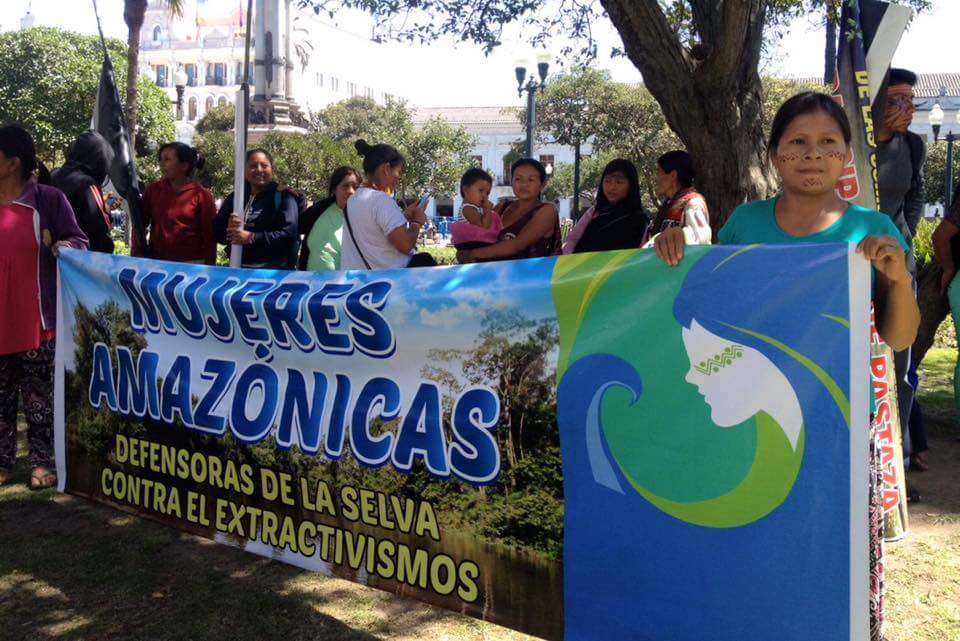
by Deep Green Resistance News Service | Mar 14, 2018 | Indigenous Autonomy
Featured image: Indigenous women gathered at the Independence Plaza to hand down their demands to the president. Credit: Yasunidos
by Pablo Orellana Matute / Intercontinental Cry
PUYO, ECUADOR – As in many spots around the globe, Women’s Day in Ecuador was marked by manifestations vindicating their role within society. For Indigenous women in the country, this was no exception. Unlike the short-lived momentum of the date, however, their strategy extended well beyond commemorative schedules. Their objective was clear: Their voices had to reach the country’s Presidential Palace.
For over nine months, political dialogues between Indigenous organizations and President Lenin Moreno’s government have left scattered results. Yet the gap from words to deeds remains firmly in place. The government’s reluctance to fully implement compromises was exposed when, early this month, the Minister of Hydrocarbons announced that a further oil auction is underway despite an explicit commitment to the contrary.
Or worse, when Ecuadorian Minister of Mines Rebeca Illescas, in a clear act of defiance, bypassed Indigenous legitimate leaders and introduced a co-opted low-rank Indigenous representative to give support to the country’s participation at the Prospectors and Developers Association in Canada (PDAC), a major mining investment event earlier this month, a move that was promptly repudiated by Shuar Indigenous Leaders.
Negotiations with the Moreno administration continue with no promising prospects despite all these low blows. Yet what the government did not see coming was that an unexpected group of major players is starting to take its toll on the discussions with a voice of their own: Indigenous women.
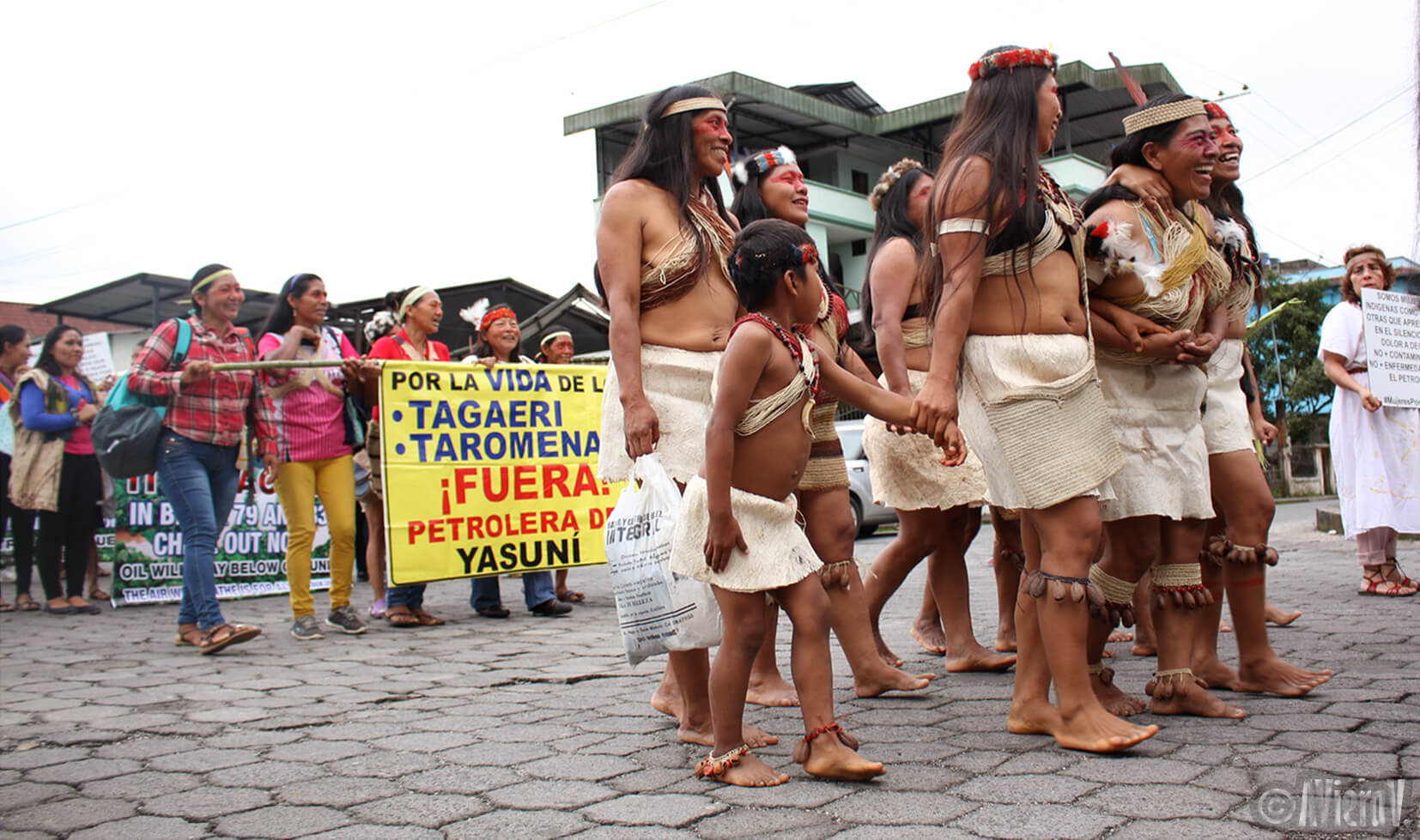
March in Puyo on Women’s Day. Credit: Andrés Viera V.
From the heart of Ecuador’s Amazon
In Puyo, the capital of Pastaza –Ecuador’s biggest Amazonian province–, Indigenous women from all over the Amazon region started off their own efforts to further pressure the government. Leaders of seven nationalities including the Andoa, Achuar, Kichwa, Shuar, Shiwiar, Sapara and Waorani were present at the event.
Led by female Indigenous leaders from the Confederation of Indigenous Nationalities of the Ecuadorian Amazon (CONFENAIE), the main Indigenous organizations in the Oriente region, the movement strategically crafted a bold agenda that extended for four days.
On March 8, seizing the visibility of the date, the events set off with a march that set the tone for their demands in defense of their territories. Around 350 Indigenous women from across the Ecuadorian Amazon marched down the streets of Puyo to speak up against the extractivist industries.
The message was clear: They had had more than enough of the contamination and exploitation of their territories.
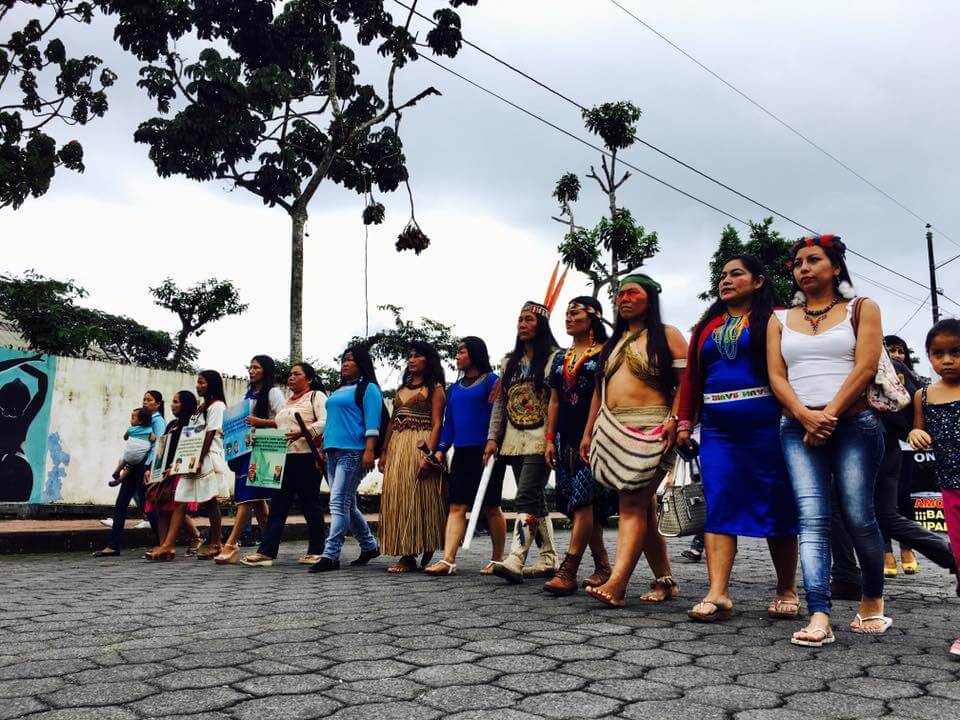
March in Puyo reassembling Indigenous female leaders from seven nationalities of the Amazon region. Credit: Yasunidos
The march was followed by a three-day gathering in Union Base, a landmark concentration spot at the outskirts of Puyo from where major Indigenous protests have been launched in the past. IC Magazine attended the event, which included the establishment of a women-only Assembly of Amazonian Women. For the inaugural session on Friday, March 9, around 400 assembly members had registered, including female leaders and representatives from across the country who had responded to the call of the organizers.
Upon inaugurating what was going to be a three-day session before embarking on a trip to the country’s capital, Elvia Dagua, CONFENAIE’s Leader of Women, reminded the audience that “Women’s Day is not March 8 alone, but every single day of the year.” This, she said, is because there is no life without women, before inviting the few male attendants to also join their cause.
“Together, men and women, we are going to defend our Mother Earth,” she said, as she opened the floor for participants to intervene.
According to Patricia Gualinga, a well-known Indigenous leader of the Sarayaku community and also a participant of the congress, the goal of this series of events is to make women’s voices and proposals heard. In her view, their aim is to awaken public opinion in the face of their latent fearsof what lies ahead. The government, Gualinga told IC Magazine, is calling for another oil auction in the South-East of the country’s Amazon, which is the reason why women are raising their voices in unity.
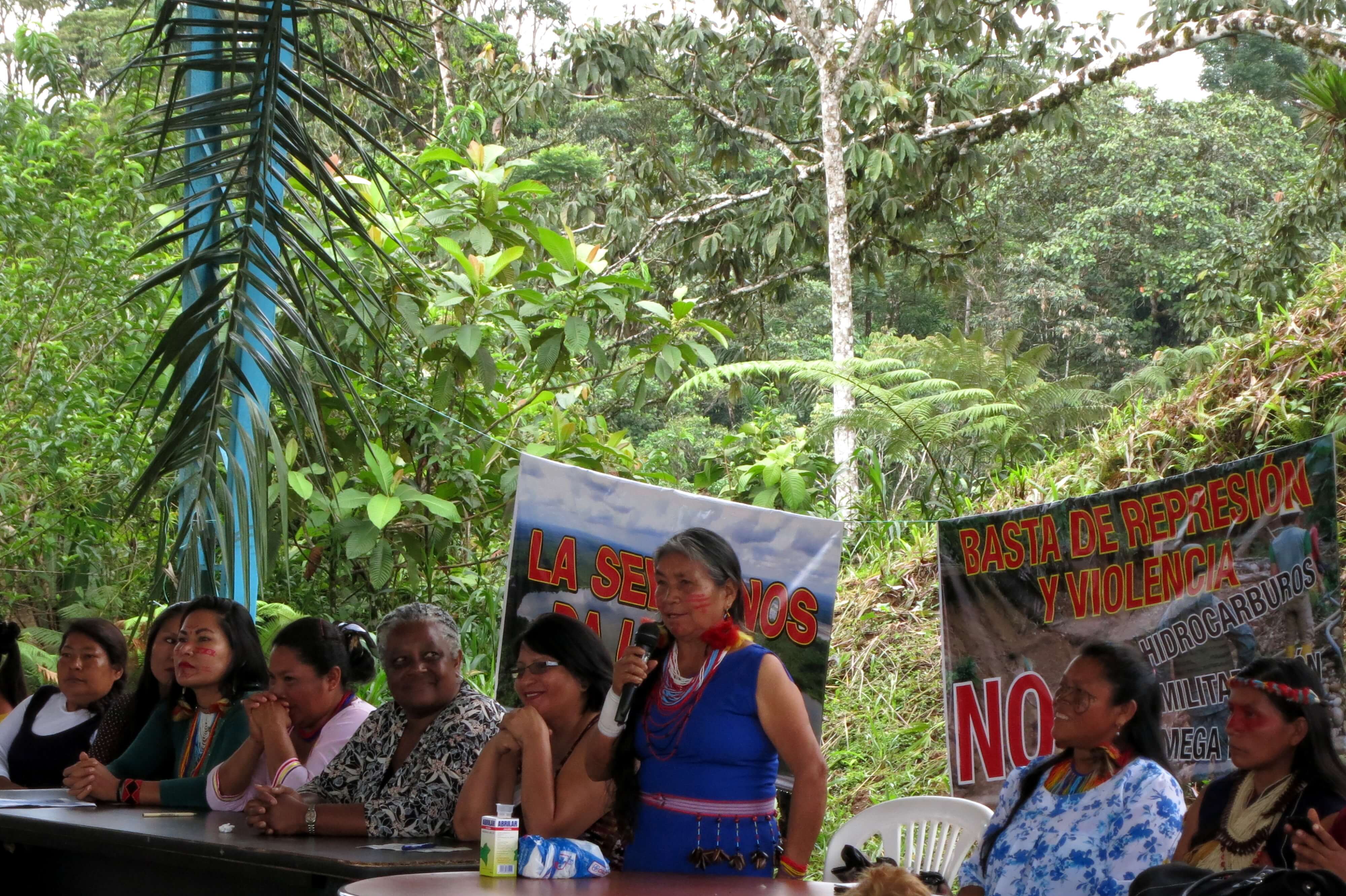
Leading panel for the Assembly of Amazonian Women on March 9 in Union Base. Credit: Ursula Cliff
Towards a different relationship with Nature
Throughout the opening session, assembly participants were asked to share their own experiences with extractivist activities, as well as to advance concrete proposals for overcoming them. Be it caused by mining or oil extraction activities, stories portraying violence and discrimination cut across themes that marked the interventions.

A participant at the Assembly of Amazonian Women. Credit: Ursula Cliff
Another recurring topic was the importance of such events in bringing together efforts to speak with one voice. Alexandra Proaño Malaver, president of the Andoa nationality located in the province’s far eastern border with Peru, expressed to IC Magazine her desire for local communities to further be included in such events.
“For us women, to talk about the defense of our territories and of life itself, we should do it from the communities” she said. The struggle should not only come from those women who live in the city, she explained, for it is “us, Indigenous women, that day by day are sowing and harvesting […] and thus sustaining life in our communities.”
Far from excluding men, all female leaders talked about a certain gender balance. Proaño, for instance, reckoned that “equity between man and woman is very important for [them]” while pointing out the experiences within her own nationality. A point that was further corroborated by Gualinga when she said, “We do not exclude men; we actually strengthen the relationship between (women and men).”
“This is simply a kind of space where we women regain our own voice,” she added.

Patricia Gualinga’s intervention in the Assembly of Amazonian Women unveiling the Kawsak Sacha project of the Sarayaku community. Credit: Andrés Viera V.
During her long-awaited intervention within the assembly, Patricia Gualinga unveiled her community’s proposal for overcoming the constant failures of what in her view are top-down approaches for the protection of the Amazon. Elaborated by members of the Sarayaku community, Kawsak Sacha, Living Forest in Kichwa is a new scheme when it comes to natural conservation, she said, that leaves the responsibility of the protection of the Amazon in the hands of Indigenous people.
In her view, this is a proposal that intends “to change the conception of everything that we have been taught at school,” for it is based on her own ancestral traditions and Indigenous ways of relating to Nature. The project’s goal, she said, is “to transform the whole scheme on which the current and obsolete economic system is based.”
Without providing further details as to the specifics of the project besides a major launch event in Quito in the coming months, Gualinga’s intervention served rather to spur the mood of the audience.
“This is a proposal for and by us; nobody has done the thinking for us,” she proclaimed in a boost to the pride of Indigenous women and their holistic relation to Nature that they want to share with the world.
Alicia Cahuiya, another experienced Indigenous leader from the Waorani nationality located in Yasuní National Park, shared with IC Magazine some key insights as to the overall message they are trying to send. “The government needs to understand that these are ancestral territories,” she said. “We don’t want more oil and mining companies; our territories need to be respected.”
Confronted with the government’s continued neglect, their message seems to preserve the living voices of the Amazon. “This is our home; here we have lagoons, waterfalls and animals and they all have spirits,” Cahuiya said, the government needs to grasp that “they all need to be included and heard, because our lives are interconnected with theirs.”
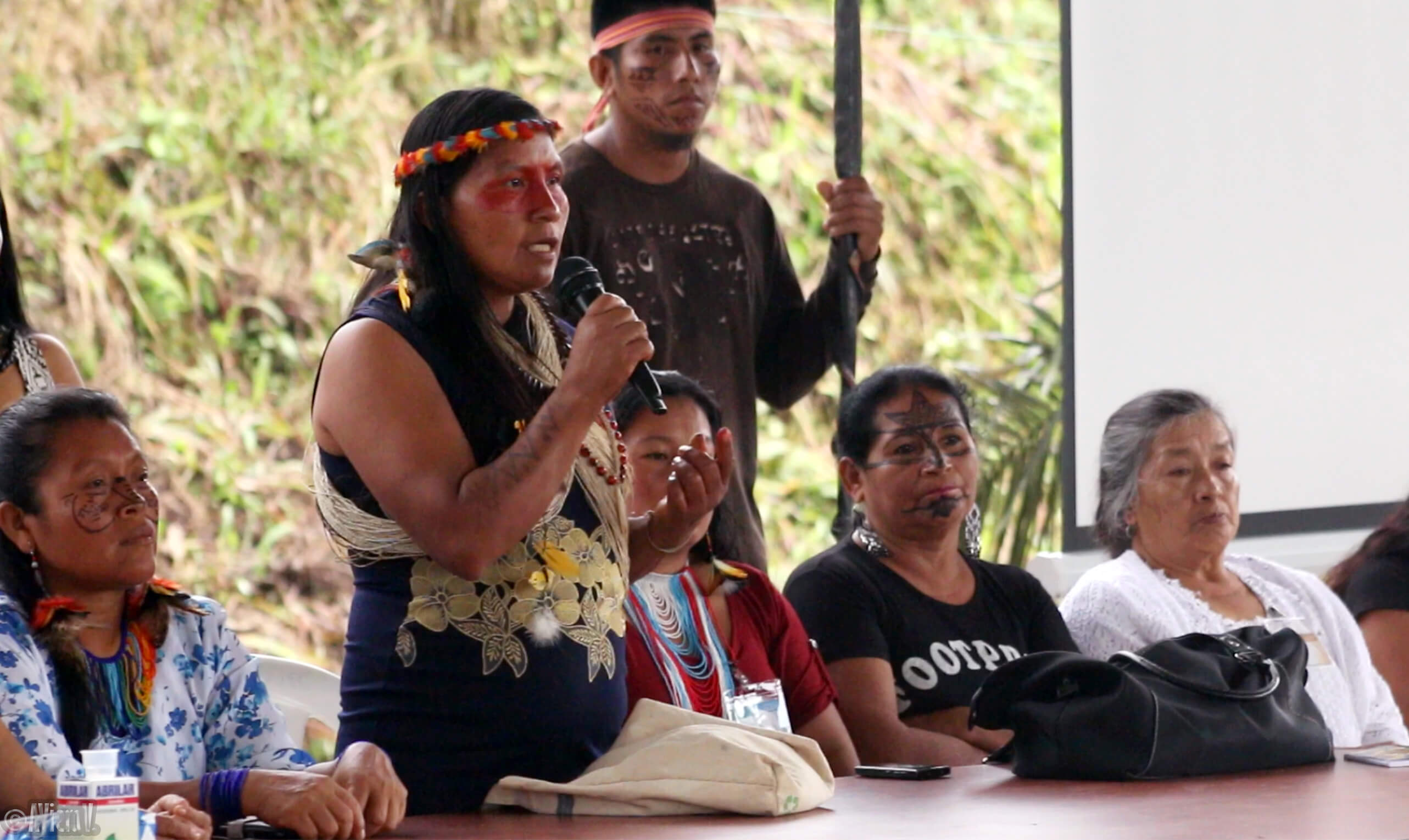
Waorani leader, Alicia Cahuiya, intervening in front of the Assembly of Amazonian Women to expose the dangers of the oil industry within the Yasuní National Park. Credit: Andrés Viera V.
Standing up in unity, directly defying power
The working sessions in Puyo resulted in a document that incorporated all their demands. The next and final destination was Quito, Ecuador’s capital, to hand down their ‘mandate’ to the President himself.
Indeed, on Monday, March 12, the march reached the capital for a press conference scheduled at the Independence Plaza, right in front of the Presidential Palace.
The collectively crafted document called Mandate of Amazonian Women included 22 specific requests headed by the most urgent demand: rejecting what they consider “illegal contracts or agreements between local authorities and any oil, mining, hydroelectric or logging company,” for “we are more than 50% of the Indigenous population, we are the carriers of life and take care of our families and Mother Earth.”
The document also included, among others, their rejection to the upcoming oil auction of 16 blocks located in Ecuador’s South-East Amazon region, their request to overturn recent oil concessions in blocks 79, 83, 74, 75 and 28, as well as their solidarity and demands for the liberation of Indigenous leaders Bosco Wisum and Freddy Taish, arbitrarily imprisoned for their upfront rejection of mining activities in Shuar territories in Morona Santiago, the country’s southernmost Amazon province.
Despite mild police repression in front of the Presidential Palace, the leaders of the Indigenous women conveyed their willingness to stay until the President hears them. As of the time of this publication, Lenin Moreno had not given any response. Whether he will attend those demands or not, the message has been clear. The striking echo of their demands will be hard to ignore, for voices of the Amazon have now joined their cause.

Indigenous women gathered at the Independence Plaza to hand down their demands to the president. Credit: Yasunidos


